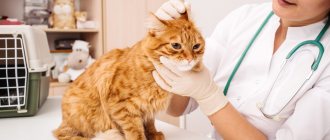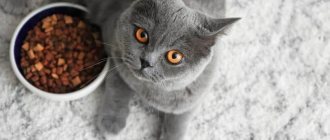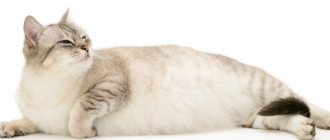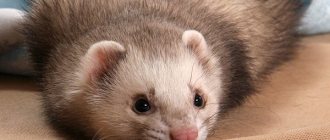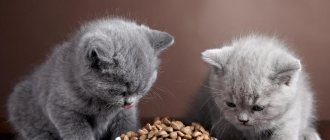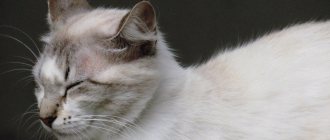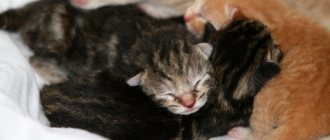All owners who decide to get a tiny mustache are advised to familiarize themselves in advance with how to care for a kitten. In the first months of life, he strongly resembles an ordinary child. A furry baby requires a lot of attention and care, so experienced breeders recommend taking a short vacation while it adapts.
At what age is a kitten taken to a new home?
Caring for a one-month-old kitten is the most problematic. Don’t rush to take home the little lump you like immediately after meeting him. There is a chance that he needs a little more time to gain strength before moving to a new home.
Perfect time
The optimal age for separation from a mother cat is 2.5-3 months. From this moment on, her cubs switch to a normal diet, so the stress from the sudden loss of a beloved breast will be minimal.
It is also important for the future owner that the appearance of a three-month-old cat is unlikely to change. Small variations are only acceptable among a limited range of breeds, including the Siamese. These snow-white beauties will gradually darken for almost a year, so be sure to capture such a unique moment with a series of photographs.
Help getting used to a new home
Unlike adults, small pets quickly adapt to a new place and get used to their owners. But don’t be surprised that in the first days the baby will miss his mother a lot. Puzzled by her search, he can turn the entire apartment upside down, so remove all dangerous objects from his path in advance.
For easier adaptation, it is recommended to take something from a nursery or shelter that is saturated with a familiar smell. Its aroma can calm the cat in moments of sadness.
Getting to know new family members should happen gradually. If there are other cats in the house, be sure to make friends with them to avoid conflicts in the future. Let your pets get used to each other's scent from a distance and only then bring them nose to nose.
Kitten nutrition
How to care for a kitten
It is better to feed the baby on time, with even intervals between meals:
- up to 2 months – 5 times;
- by the age of six months, the frequency of feedings gradually decreases to 3 times, and the portion gradually increases;
- An eight-month-old animal is fed like an adult - twice a day.
Your pet's diet must include:
- raw beef;
- boiled chicken meat;
- milk porridge;
- egg yolk;
- raw and boiled vegetables;
- fermented milk products.
You cannot feed food from the human table: salt and spices are harmful to the cat’s body.
Be sure to read:
How to wash a cat's eyes at home: pharmacy and folk remedies, when required
Veterinarians recommend purchasing balanced cat food for kittens, taking into account age. Specialized mixtures contain all the necessary elements necessary for the growth of a pet.
What should you buy for your baby first?
Before the arrival of a new family member, you need to arrange a personal corner for him and take care of buying basic things. Thanks to the inviting environment, your mustache will get used to the change of residence much faster.
Tray, filler and scoop
To relieve yourself, you will need a closed or open tray. The first type perfectly masks odors, but due to its impressive size it often crowds the human toilet. The second type often confuses people with dirt. Because of this, experienced owners recommend taking a model with a mesh and placing the filler not on top, but directly under it.
The filler itself is:
- woody;
- grain or paper;
- silica gel;
- clay or mineral.
Each type has its pros and cons, so study them carefully before purchasing. You will need a scoop to pour the filler. It can be purchased at any pet store or replaced with a children's spatula.
Carrying
This accessory will be needed not only for traveling to the country, but also for going to the veterinary clinic. If you are planning a long trip on a train or plane, choose a hard plastic model. In other cases, you can get by with a soft fabric carrier.
Please note that interactions with doctors rarely leave pleasant memories. If you take out the carrier only for this purpose, your pet will begin to hide from it under the sofa. For this reason, it is better to store it in a visible place so that the cat gets used to its smell.
Bowls for food and water
The required number of bowls depends on the diet. At a minimum, you will need 2 pieces: for food and fresh water. Another one may come in handy when feeding wet canned food.
The most reliable materials are metal and ceramics. Cheap plastic products quickly absorb foreign odors, and dangerous bacteria settle in their cracks.
Bed
The baby will choose a sleeping place on his own, so do not rush to install a cat bed without his consent. An open lounger or a special house is suitable for sleeping and relaxing. The first option is ideal for an unobstructed view of the territory, and the second is indispensable for modest pets who love silence.
scratching post
Without this item, you can say goodbye to your favorite sofa and recently hung wallpaper. For an active mustache, a large play complex with several tiers is suitable, where he can sharpen his claws, have plenty of fun and even sleep. For calm animals, a simple scratching post will suffice.
Feed
It all depends on age. If your baby has already started teething, then choose the type of food that is comfortable for you: natural or dry. The quality of the finished granules must be no lower than premium, since consuming economy grains can result in serious health problems.
Kitten 3 weeks care
Any animal, especially if it is young, requires careful care from the owner, as well as constant monitoring of its health. It is for this reason that it is worth paying attention to the fact of what your baby eats, how he feels, and the condition of not only his integuments, but also his internal organs.
If a kitten appears in your house, whose age is three weeks, then you should become not just its owner, but a real mother cat.
Therefore, create a special feeding regimen and be sure to follow it.
The main product that should be given to your baby is milk. In this case, you should not give him cow's milk, regardless of whether it is homemade or purchased. This product contains much less protein than a small growing organism needs. It is best to purchase a special mixture that is perfect for feeding.
There is a simple cooking recipe that must be followed. For half a liter of milk you need another 3 teaspoons of sugar and ground boiled yolk. If after this composition the kitten begins to have diarrhea, do not worry, change the concentration by adding a glass of boiled water.
In addition to the above nutrition, it is also necessary to add some new foods, but in small portions.
Kitten 3 weeks old, increased care.
Additional products - finely chopped beef (boiled), fish (sea fish, boneless, boiled), cottage cheese (low-fat, preferably purchased).
Do not forget that when feeding the animal, you must first let it smell the product. If a kitten refuses to eat food, there is no need to force it and just stuff this or that product into its mouth, perhaps the baby is simply not yet ready to eat such food. But if he refuses to drink milk, then measures need to be taken, and the sooner the better.
Usually kittens are fed from a baby bottle with a nipple, but if the baby refuses to eat, use a syringe without a needle. Pour small portions directly into your mouth. Due to the absence of cheeks in animals, some of the product may spill out, but the most important thing is that at least some of it gets into the stomach.
Please note that the statement that the one we have tamed needs us and we are responsible for him is the truth, and therefore, having brought home an animal, even the smallest one, anyone should take care of it and make sure that its condition is at least normal and as a maximum - the best.
What else will a tailed newcomer need?
The remaining items are considered additional, as they can be purchased a little later. They include tools and care products, as well as a variety of toys. There is no point in delaying their purchase, since hygiene procedures should be taught from childhood.
Claw cutter
To shorten claws that are too long, you will need a nail clipper. It differs from nail scissors in having a special recess for the claw. With this tool you don’t have to worry about peeling the nail plate or accidentally getting injured.
Accessories for combing
Without proper care, long-haired breeds quickly turn into a giant ball of tangles. Due to matting, hairs become thinner, break and fall out.
Combs with natural bristles and wide teeth, made of metal, as well as a special mitten brush will help preserve the beauty of your fur coat. During the molting period, a furminator can be used to remove fallen hairs.
There is no need to skimp on combing accessories. Ordinary plastic strongly electrifies wool, worsening its appearance.
Oral hygiene products
You need to brush your teeth not only for yourself, but also for your pets. Cats, like us, are not immune to caries and other oral diseases.
To care for your teeth, you will need to purchase veterinary toothpaste and a brush. A very comfortable model that fits directly on your finger.
Toys
Games are loved not only by ordinary children, but also by little cats. With their help, they learn the basics of hunting and throw out the energy accumulated during the day. Such activity has a positive effect on health, so the furry couch potato should be involved in joint games even as an adult.
Balls, mice and interactive toys are suitable for independent games, and teaser fishing rods for joint games. But you can also save money by making your own toy from thread and candy wrapper.
Other skin care products
To prevent ear pathologies, you need to keep your ears clean. Cleansing lotions that are instilled directly into the ear canal and regular cotton pads soaked in water will help with this.
If your pet gets dirty during dusty renovations or crazy runs through the garden beds, then you will need cat shampoo to save it. An ordinary human one will not work - it can provoke an allergic reaction.
Another important tool is a special spray used for toilet training. Depending on the components, it can attract the animal to the tray or scare it away from relieving itself in the wrong place.
Solving the feeding issue
The difficulty is that newborn kittens need extremely frequent feeding - in the first week of life they need to eat at intervals of 2 to 4 hours, then from 4 to 6 hours, in portions of 4-5 ml per 100 g of the kitten's weight.
And you need to do it correctly:
- Take care of the necessary food - cat milk replacer from Royal Canin is ideal (buy it at a pet store, veterinary pharmacy or order it online). In extreme cases, it can be briefly replaced with goat's milk. You cannot feed kittens with cow's milk, packaged milk, condensed milk or yogurt, all this is absolutely not suitable for them!
- Buy a small bottle with a nipple, a dropper, or a disposable syringe. The last two items will be needed if one of the babies cannot suck.
- Before feeding, the bottle, nipple, pipette must be sterilized in boiling water, they need to cool on clean gauze.
- The milk replacer must be mixed with water according to the instructions and heated to + 35-37 ° C.
- Measure the baby's body temperature. It is impossible to feed kittens with a temperature below +35 °C; they must first be warmed up, otherwise feeding is fraught with aspiration pneumonia. The cat baby will have difficulty breathing and may die.
- Hold babies correctly - they are not human babies. The kitten should be with its paws down, with its muzzle directed towards the mother's nipple.
- But kittens, like babies, tend to burp after feeding. Place your baby on your lap and stroke his back. If there is no burping, hold the muzzle straight or feed again.
Monitor your babies' weight. Immediately after birth, they weigh from 90 to 110 g. After 2 weeks, their weight should reach 200 g, after 3 - from 280 g. From 3-4 weeks, you can begin to teach cats to drink a substitute from a saucer, mixing wet food in small doses for kittens At the age of 5 weeks, cats are already able to eat dry food.
We care about health and hygiene
Caring for newborn kittens without a cat requires you to help them not only eat, but also perform the reverse process of eating—a cat does this.
In the first weeks of life, kittens are not able to defecate on their own. Before and after eating, place the babies on their backs and wipe their abdomen and bottom using a cotton pad soaked in warm water (this way you imitate licking them by a cat, stimulating the work of the stomach and intestines). Lick in one direction. After defecation, wipe the cats clean again with a damp cotton pad. The color of urine of cats at this age is pale yellow, it does not smell. The color of the stool is brownish-yellow. Strong odors and changes in the color of stool are a reason to consult a veterinarian!
After feeding and defecating, the cats need to be “finally licked,” imitating their washing by a mother cat. She does this with her tongue, you with a damp cloth soaked in warm water. Dry the babies' fur with a towel and send them to rest. And after 2-3 hours - it’s all over again!
Caring for newborn kittens is a complex and responsible matter. Stay in touch with your veterinarian - he will always tell you what to do in this or that incomprehensible situation.
The most important point is feeding
Proper nutrition is the key to your pet's health. Pay special attention to this moment.
When feeding naturally you should avoid:
- river fish and bones;
- white cabbage and legumes;
- lard and pork;
- pearl barley, corn and millet;
- mushrooms and potatoes;
- sorrel, onion and garlic;
- raisins and grapes;
- any products from the human table.
With dry food everything is much simpler. Here it is important to focus on the standards specified by the manufacturer, not to buy low-quality brands and choose age-appropriate lines. Please note that you will have to adhere to the chosen type of nutrition throughout your life.
Feeding a newborn without a mother
Newborns are fed special formulas, the composition of which is close to cat milk. Cheaper options (goat's and cow's milk) are fraught with vitamin deficiency and intestinal disorders in babies.
Prepare for sleepless nights. For the first 2 weeks, the cat will have to be fed every 2-3 hours, that is, approximately 7-8 times a day. A night break (no more than 5 hours) can be introduced only in the 3rd week. It is better to check the daily dose with a veterinarian, since it is very easy to overload a child’s stomach.
Feeding at 1 month: introduction of complementary foods
At 3-4 weeks, the first milk teeth appear, so caring for a 1-month-old kitten differs from caring for a newborn. From this moment on, the first complementary foods can be introduced into the diet. All food served must be boiled and crushed to a puree-like consistency.
The baby is fed 6-7 times a day in small portions of 17 g. In addition to milk, the menu includes boiled yolks, minced meat, milk porridge from semolina and rice, low-fat fermented milk products and vegetable puree.
Feeding from 2 to 4 months
Caring for a kitten for 2 months is supplemented by the inclusion of solid food. Well-frozen and boiled meat and fish are cut into small pieces, replacing minced meat with them. The daily portion is increased to 150 g, and the number of feedings is reduced to 5.
From 3 months, when calculating portions, the weight of the animal is taken into account, as the body enters a phase of rapid growth. For every kg of weight there should be 200 g of food, and the frequency of feeding should be reduced to 4 times.
The amount of fermented milk products is reduced in favor of meat and raw vegetables. It is also recommended to give up milk and reduce the amount of water used when cooking porridge.
Feeding from 5 to 7 months
Puberty often occurs during this period. Pets of different sexes living under the same roof mature before anyone else.
The regime is gradually being brought closer to that of an adult, so that the eight-month-old cat no longer eats 4 times, but 2 or 3. The portion also increases, since the weight does not stand still. This indicator should be monitored very carefully, since undersupply and excess are equally harmful to health.
Feeding a grown pet
Older cats are fed twice a day, but the veterinarian may make some changes to this routine. Make sure your pet gets enough protein, fat and carbohydrates. The ideal percentage ratio of these elements is 52:36:12.
The majority of the diet should consist of proteins of meat origin, that is, meat, fish and offal. The menu also needs to include vitamins and minerals that cannot be replenished with regular food.
Feeding
Cat's milk can fully meet the nutritional needs of the offspring during the first 4 weeks of life. But if newborn babies are left without a mother for some reason, you should first of all take care of the competent selection of a milk substitute.
Important! To choose the right nutrition for newborns, you need to know the composition of cat milk. It has a higher content of fat, vitamins and minerals compared to cow's milk, and the amount of protein in it is almost twice as high. Additionally, it contains taurine, an amino acid necessary for the cat’s body to break down fats.
Nutrition selection
If the problem of selecting food takes you by surprise, at first you can use formulas intended for infants, which are diluted with boiled water 1.5-2 times more than the norm specified in the instructions.
Whole cow's milk is not suitable for feeding, since it practically does not contain taurine and other vital nutrients, and therefore can cause digestive disorders, diarrhea and even death. Closer in nutritional composition to cat milk is goat milk, except for the very low level of taurine. When using goat's milk, you should dilute it with boiled water in a 1:1 ratio and add 1 quail egg for every 50 grams of the resulting mixture.
The ideal option for replacing cat milk is special formulas for kittens, which can be purchased at a pet store or veterinary pharmacy. They are as close as possible to the composition of cat milk, enriched with essential amino acids and do not cause digestive disorders or allergic reactions if used correctly. Some manufacturers use packaging in small disposable bags and also complete the mixtures with bottles and nipples, which is very convenient for use.
Feeding mode
In addition to choosing the right milk replacer, it is necessary to properly organize the process of feeding without a cat.
An approximate feeding schedule depending on the age of the kitten is as follows:
- 1-13 days – after 2-3 hours, regardless of the time of day;
- 14-24 days – every 2-3 hours during the day, 1 time at night;
- 25-35 days - every 3-4 hours during the day, night feedings are optional.
When increasing the intervals between feedings, it should be taken into account that babies are not always able to eat a full portion at one time, so sometimes they have to be fed additionally after another half hour to an hour.
It is important to control weight gain in the first 3 weeks of life: the minimum is 5 grams, the optimal is 10-15 grams per day.
Feeding rules
The best option is to imitate the behavior of the mother cat: stroke the baby on the back and forehead before feeding. This can be done using a sterile wipe, imitating the movements of a cat's tongue to stimulate the sucking reflex and improve digestion. While eating, you can also make light stroking movements and even purr or quietly say something, similar to a cat's purr.
The mixture should be fed from a small container through a nipple. If the bottle with nipple was not sold with the mixture, you can purchase it separately at a pet store or use the rubber part of an eye dropper for this purpose by making a hole in it.
In some cases, you can use a disposable syringe without a needle, but it is not advisable to do this all the time because:
- firstly, there is a high risk of choking and drowning;
- secondly, the sucking reflex is weakened, which is fraught with digestive problems.
It is also important to maintain a certain food temperature: in the first 3-4 days it should be within 36-38°, and in subsequent days – 30-32°. Too cold food is fraught with digestive disorders and hypothermia, which is unacceptable for newborns.
The feeding procedure is as follows: place the baby belly down on your lap or on the table, but in no case belly up. Next, carefully insert the pacifier into the mouth, holding it at an angle of 45° and shaking it slightly so that he begins to instinctively suck on the contents. You need to feed until he sucks. A well-fed baby’s tummy becomes rounded, he doesn’t squeak, and falls asleep almost immediately. When he has eaten, you should wipe his face and other dirty areas of the body with a piece of cloth soaked in warm water. After this, you need to place the animal in an upright position to remove excess air from the stomach and promote digestion.
The development of kittens is negatively affected by both underfeeding and overfeeding. The main indicator will be the color of the stool, which normally should be golden brown in color and have a dense consistency. Possible deviations:
- yellow liquid – minor overfeeding;
- greenish – moderate overfeeding;
- gray – constant overfeeding (can also be a manifestation of infection, so in such cases a veterinarian’s consultation is required).
Lure
At the third or fourth week of life, you can already offer a milk replacer in a shallow bowl. The same time is suitable for gradual accustoming to solid food. The introduction of new products begins with minimal portions (literally the size of a pea) and requires constant monitoring of stool. Food should be given in a small bowl, leaving it in an accessible place. It is also important to provide free access to water.
The following can be given as complementary foods:
- dairy products (kefir, fermented baked milk, cottage cheese, sour cream);
- chopped meat, previously scalded with boiling water (beef or chicken);
- boiled and chopped vegetables;
- porridge;
- ready-made food with a specialized, age-appropriate composition.
Kittens need to be bowl fed several times a day so that by the time they are 5 weeks old they are accustomed to their new feeding routine.
Hygiene procedures
Knowing how to care for a kitten at home, you can easily avoid diseases that arise due to insufficient hygiene. The care products discussed earlier will help you with this.
Teeth cleaning
This procedure will not take much of your time, since on average a cat's teeth need to be brushed only once every 2-4 weeks. On other days, it is recommended to use chewing toys and special treats to prevent the formation of tartar.
Cleaning ears and eyes
The ears are cleaned every 2 weeks, and the eyes as they become dirty. For this it is better to use a cotton pad. Ordinary cotton wool can injure the mucous membrane with its villi, and a cotton swab can damage the eardrum. In addition to lotions and water, herbal infusions of chamomile or calendula are suitable for cleansing.
Nail trimming
Overgrown claws are trimmed without affecting the pink part of the plate. This is done as it grows, not forgetting to disinfect the nail clipper before each procedure.
Is it necessary to bathe your pet?
Before vaccinations, it is better not to wash the kitten, since due to temperature changes, the fragile body can catch a cold. In other cases, swimming is permissible, but only if it is heavily soiled.
How to care for a kitten at home
The formation of the body, health and life expectancy of an adult cat depend on proper care in the early period of life.
The formation of the body depends on proper care in the early period of life
Caring for newborn kittens
If the babies are with a cat, then the mother takes care of the offspring and the owner has few worries.
Need to control:
- "Nest" state. Clean the litter from wool and dirt.
- Weight gain. Newborns weigh approximately 120 g and, with normal development, gain 100 g weekly. Kittens grow a little faster than female cats. If the baby is growing more slowly, then he needs to be shown to the veterinarian.
- Condition of fur, eyes and ears. The coat should be dry and clean, and there should be no discharge from the ears and eyes. The cat's mother licks her offspring and healthy babies are always clean.
On the 8th day, the eyes open, by the end of the second week the babies begin to hear, and on the 20-21st day the kitten tries to walk.
There is no need to worry about newborns: the babies eat and sleep, actively gaining weight.
As soon as the baby opens its eyes, stands on its paws and begins to show interest in the world around it , the kitten needs to be picked up and stroked. Positive human contact will help the animal grow up affectionate and playful.
Care at 1 month
At this age, it is better not to take the baby away from its mother.
As soon as the baby opens his eyes, stands on his paws and begins to show interest in the world around him.
But if for some reason a month-old kitten is alone, then it will require special care:
- Feeding. The main diet should be milk. It is better to purchase a cat milk substitute at the veterinary store or dilute the dry milk by adding a little honey or sugar. Complementary foods (meat, porridge) are added in small doses. New food should be given in small quantities so as not to cause intestinal upset. You need to feed 6 times a day.
- Providing peristalsis. The cat licks the baby's tummy, stimulating intestinal function. To help the pet, the owner needs to moisten a cotton pad with warm water and massage first the sides and then the tummy in a circular motion from the sternum to the groin.
- Fresh water. If food is given on a schedule, then water should be in the bowl at all times.
Be sure to read:
Reasons and ways to suppress a cat’s aggression and calm the animal down if it gets angry, meows, cries before bedtime
The animal must be toilet trained immediately. If the kitten begins to worry and “look for a place,” then you need to take it and put it in the tray.
You need to be persistent if the baby tries to run away and refuses to “do his business” in the designated area. The procedure must be carried out several times until the small pet understands where to defecate.
If your pet refuses to go to the litter box, then perhaps he is frightened by the large granules of the filler or does not like the consistency. By changing the toilet filling, you will be able to cope with the problem.
At this age, you should begin to accustom long-haired kittens to brushing. It is better to purchase a soft brush that detangles the fur and does not scratch the skin: then the combing procedure will be perceived as a pleasure by your pet.
Taking care of your health
A homebody cat is not immune from infection by parasites and viruses. For this reason, it must be regularly treated against various pests and vaccinated.
Treatment for ectoparasites
Preparations for fleas, ticks and other ectoparasites are used during periods of increased activity, before mating and vaccination. The method and frequency of use depend on the type of product chosen.
Deworming
Treatment for worms is carried out every quarter or every six months. Deviation from the schedule is possible only with direct infection or vaccination, participation in exhibitions, travel abroad, as well as with surgical intervention.
When do you get vaccinated and get a veterinary passport?
The first vaccination is given at 2-2.5 months, that is, after separation from the mother. All data on the administered drug is included in the veterinary passport, so this document is created after the first application.
The decision on castration, sterilization and their timing
The ideal age for surgery is 7-8 months. It is recommended to sterilize the cat before the onset of her first heat, as this reduces the likelihood of developing cancer in the future to 0.5%.
Development of kittens by week: features, what they look like
The weight of kittens at birth depends not so much on the breed, but on the number of cubs in the litter, as well as the age of the cat. It is believed that the average weight of newborns is 100 grams. Since the standards for kittens of different breeds are not the same, you can focus on the parameters for outbred individuals.
Kittens are born blind and deaf, but they easily find nipples and do nothing but eat and sleep. Experienced felinologists recorded their observations in writing and share their knowledge with colleagues. It is useful to keep such data because it will provide an invaluable service when it comes to seeking veterinary help.
Features of development in the first week
In the first hours of life, kittens feed on colostrum. It is rich in globulins, which contain maternal antibodies. The baby’s intestines do not digest them, but pass them into the blood. Globulins will protect the kitten’s body from viruses and bacteria until 6-8 weeks of age.
The body will perceive milk proteins as foreign. The valve cells will close and only low molecular weight fragments of digested proteins will enter the blood.
On the second day, some kittens' umbilical cords fall off. By the fourth day of life, in normally developing cubs, the remnants of the former connection with the placenta are lost. By the fifth day, babies hear everything and distinguish smells. In kittens of certain breeds, the eyelids open on the 6th day of life, however, full vision is established after two weeks.
In kittens of the first seven days of life, the mechanism of thermoregulation has not formed. Therefore, they are prone to hypothermia in those rare moments when the mother leaves the nest. It is important that the windows are not opened in the room with children.
Be sure to read:
How to feed a newborn kitten without a cat at home
An indicator that the kitten is developing correctly is a doubling of the initial weight by the age of one week.
Development over 2 weeks
In the second week, the cubs already respond well to sounds. Eyes open, baby teeth erupt. The kids are actively crawling around the house.
The coat grows, becomes thick, and an undercoat begins to form. The susceptibility to drafts and temperature changes is reduced, but the animal is still vulnerable. The waking time gradually increases.
Development in the third week
The kitten begins to distinguish objects, his hearing is well developed. By the end of the period, the initial mass triples. The baby makes attempts to stand on 4 paws and begins to play with his mother, sisters and brothers.
But the movements are still uncoordinated and the baby constantly bumps into the walls of the den. The kitten begins to respond positively to stroking.
Development at 4 weeks
Baby teeth erupt one by one. By the end of the week, the pet has 26 of them. The baby is interested in the contents of the mother’s feeder and tries the granules, which should be constantly available to the lactating cat. To make the transition from milk to solid food easier for kittens, it is recommended to feed lactating cats ad libitum with dry kitten granules.
From three weeks of age, the granules are soaked and given to try. Every day the amount of water becomes less and less. For babies, bowls with low edges are placed so that they get used to drinking.
The kittens try to run with varying degrees of success and play with each other. At this time, it is time to accustom the animals to the tray, which is placed not far from the den. At 4 weeks, kittens should be dewormed for the first time. Worms are transmitted to babies in utero or by licking the mother's fur coat. 7-10 days before the first vaccination at 8 weeks of age, kittens are dewormed again.
Getting rid of parasites helps maintain high growth rates. At this time, it is necessary to check your pet for flea infestation. The means used to drive away ectoparasites from the mother are not suitable. Therefore, repellent shampoos are used to repel fleas.
The insecticide is washed off with water. Repeated treatment is carried out no earlier than a week later. The cat is also treated by applying drops to the back of the head or back. For a while, until the insecticide dries, the mother is isolated from the kittens so that they do not ingest a substance that is toxic to them. Anti-flea collars should not be worn on nursing females for the same reason.
Development at 5-6 weeks
A five-week-old kitten learns to wash and lick itself. The eyes change color from dull blue to the coloring characteristic of the breed. The number of feedings is 5 times a day. The cat begins to be prepared for weaning. It is believed that by the age of six weeks the kitten does not need milk and can be given to a new owner. However, an alternative opinion claims that the baby still needs instructions from the mother.
Be sure to read:
Is it possible to feed a cat dry and wet food at the same time: rules, pros and cons
Some felinologists believe that the kitten should be given the opportunity to suckle its mother while she has milk. Others believe that prolonged lactation undermines the cat’s health and stops lactation by eliminating dairy foods from the diet and limiting drinking.
An alternative is the use of drugs that stop lactation: Lacto-Stop or Galastop. The babies are actively growing and by 6 weeks they weigh, on average, from 600 to 900 g. The undercoat is growing. At this point in their development, kittens are the most playful and very active, running around the apartment and getting under the owner’s feet.
7 and 8 weeks from birth
Regardless of whether the kitten is with new owners or continues the process of learning the behavior characteristic of cats in the company of its mother, it is prepared for the first vaccination, which is usually given at 8 weeks. The pet is dewormed and treated against fleas using shampoos that repel insects.
Monitor your weight gain. Two-month-old kittens weigh about 1 kg or more. The kids are litter box trained and can lead an independent life. They know how to hunt, but still sleep with their mother and littermates.
In the third month from birth
If the cub is with its mother, it continues to suckle out of habit, even when she has no milk. This time is dangerous for the kitten, because Chon tries to go everywhere. It is necessary to remove all small toys and close the doors to the balconies. The kitten becomes responsive to affection and begins to purr.
At 12 weeks the optimal time for re-vaccination occurs. 2 weeks after it, the baby is considered completely protected from the most dangerous infections. It can already be treated against fleas using insecticidal drops.
By this time, the character has already been formed, the pet goes to the tray, eats ready-made or natural food, and responds to its name. His baby teeth are fully formed. Visually you can distinguish where the cat is and where the cat is. Three months is the ideal age to change ownership and begin adult life.
Be sure to read:
Poisonous plants for cats: a list of dangerous indoor plants, in bouquets, from the dacha, what to do if you eat them
Development from the fourth to the sixth month
The growth rate is slowing down. The pet is transferred to four meals a day, and from five months - to three meals a day. Live weight is about 1.5 kg, males weigh more, males weigh less. At 4 months, the change of teeth begins, which ends by 6-7 months.
At this time, the kitten turns into a teenager, lanky and clumsy. Reacts to danger, hisses, arches his back, growls threateningly. If a pet walks on the street, catches mice and likes to brag to its owner about its hunting success.
In the seventh and eighth months
Puberty begins. Males begin to mark, the time of the first heat comes for cats, although there are breed and personal differences. Weight reaches 2.5-3 kg, in cats and more. This is the time of making a decision about the fate of the pet: whether to participate in breeding, whether to lead a promiscuous lifestyle as a cat walking on the street, or whether to castrate.
The kitten is fed 2 times a day. Use ready-made food for kittens and teenagers of premium or super-premium class or natural products of similar quality.
Development from 9 months to a year of life
The growth rate is slowing down. Feed consumption is stabilizing. Cats are going into their first heat, but they should not be bred at this time. Hormonal contraceptives should not be used either. Ten-month-old kittens have the right to participate in expert exhibitions. By this time, motor activity has stabilized, the cat finds time to sleep and play. By the age of one, the cat is switched from teenage food to adult food.
To avoid feeding stress, the transition is carried out within 7-10 days. On the first day, 15-20% of the previous food is replaced with a new one, gradually increasing the ratio in favor of food for adults.
Education methods
It’s better not to delay education. A mature animal will listen to you with much less enthusiasm than a foolish baby.
Tray training
On average, litter box training takes about 2-4 weeks. In addition to your persistence, you should pay attention to the accessibility of the tray and the privacy of the space allocated for it. A constantly open toilet door can negate all your efforts, since cats do not tolerate violations of their personal space during such intimate moments.
Training to a scratching post
Use liquid catnip and other products that attract cats' attention with their scent. Prevent damage to foreign objects so that the pet understands that everything except the scratching post is prohibited.
How can you punish a guilty animal?
As a punishment, use prohibition commands, pronounced in a strict and accusing intonation. Accompany them with a spray from a spray bottle or a newspaper clap on the floor near the offender.
Remember that assault and loud shouting are prohibited. Such parenting methods can lead to serious mental problems.
Is it possible to train a cat?
It all depends on the specific animal. Most cats can be taught the fetch command. They love to hunt and often bring balls and mice to their owner, getting involved in joint play.
